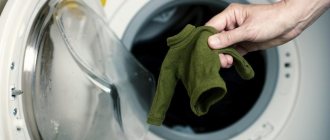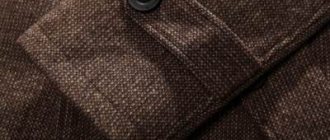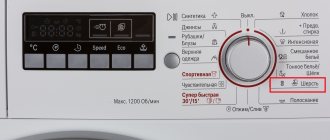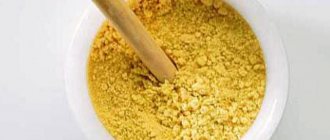Flowers, decorations for important celebrations or small decorative elements - all of this must be made from materials of the highest quality, additionally meeting the criteria of elegance and style. Organza is a fabric that allows you to achieve the perfect, stylish result in a simple way, even without special skills. It can be both natural and artificial. There are many options for using it. This is one of the materials from which you can create almost anything related to the word “decoration”. In addition, we are talking about a very elastic fabric, which makes it easier to work with. The most common products are tulle and organza curtains. Shawls and scarves made from this material are no less famous. Since it is becoming more and more popular, you need to know how to wash organza in a washing machine, both automatically and manually.
How to wash - in a machine or by hand?
In order to decide which way is best to wash a particular organza product at home, you need to have an idea of:
- fabric composition;
- type of staining;
- organza form;
- type of decoration or decoration method, if present;
- degree and composition of pollution;
- the presence of additional non-removable parts in the product.
Organza fabric varies in composition.
Most often it is made from synthetic threads woven from polymer fibers. Sometimes you can find organza made of silk, viscose, or a mixture of threads of different compositions. The fabric manufacturer is required to indicate the exact composition on the label - this information makes care easier. The housewife needs to know the composition of the fabric in order to choose the right washing mode and care products for an organza product.
According to the type of dyeing, organza can be white, colored or with a printed pattern. It can be decorated with applique, embroidery, etching or decorated with laser cutting or perforation.
Most often, organza products, such as curtains, clothes, accessories, can be machine washed. Exceptions include products containing additional non-removable rigid parts. Stage costumes and other complex products that include organza are washed by hand so as not to damage them.
When choosing a detergent, preference is given to liquid powder and gel. For hand washing, the simplest detergent is a warm solution of baby soap. Liquid products act quickly on the fabric, rinse well and do not leave streaks. It is advisable not to use dry synthetic powder products. As a rule, after washing they leave marks on the fabric.
Among the universal options, suitable for both machine washing and hand washing, gels from the Synergetic brand are in demand.
Wash by hand
Hand washing for organza is considered the most gentle procedure, as it avoids damage to the fabric.
Rules for washing organza products by hand
It is carried out in the following sequence:
- Pour warm water into the container at a temperature of no higher than 40 degrees.
- Add a neutral detergent, calculating that 1/2 tbsp is required. l. for 5 liters of water.
- Immerse the product completely in the solution and leave for 2 hours.
- Gently wash the fabric, lifting and lowering, without rubbing or twisting, using light squeezing movements.
Rinsing is carried out first in slightly warmed and then cool water. The movements are carried out without pressing. Lift the fabric and immediately place it on the rope to drain excess moisture.
How to wash organza in a washing machine
If an organza product does not have obvious stains from dirt, then it is easier to wash it in an automatic washing machine. White organza tulle should be washed using detergents that do not contain chlorine bleaches. Oxygen bleach is used if necessary. A colored or patterned veil can be washed with gels marked Color. Detergents for washing organza in a machine should not produce a lot of foam. It is not recommended to use conditioners as they may cause the fabric to yellow later.
Preparing for washing
Before washing dusty organza curtains, you must first shake them free of dust. It is better to do this not indoors, but on an open balcony or on the street. Dust, if not shaken out first, will penetrate between the fibers of the fabric during the washing process. Subsequently, it will be more difficult to wash such tulle from grayness.
Organza curtains must be soaked in a warm 10% solution of table salt with the addition of any detergent for two hours before being put into the drum of the washing machine. This is done in order to wash the organza from grayness. The dirt present on the fabric will partially dissolve, which will facilitate the removal of dirt from organza tulle in the washing machine.
Do not use hot water. At high temperatures, synthetic fabric can become stiffer, change shape, and turn yellow. After soaking, before washing directly, the product is rinsed first in warm, then in cool water.
If there are stains on the fabric, it is advisable to remove them first before washing. In order to choose the right stain remover, you definitely need to know what is causing the stain.
If tulle hangs in the kitchen, then persistent stains often form on it. Stains appear from soot and oil that often shoots out when frying, especially if the stove or sink is located not far from the window. With systematic care of curtains, fresh greasy stains can be easily washed off with standard washing. Old stains require chemical stain removal and special treatment. Organza items with stubborn stains should be washed by hand, paying special attention to soiled areas.
Step-by-step instruction
Sometimes organza can shrink when washed. This feature of the veil depends on the composition of the fabric. It can only sit if there is a high percentage of natural threads: silk or viscose. A veil embroidered with natural threads can also shrink. If the fabric contains only 100% polyester or other synthetic material, you don’t have to worry about shrinkage. To wash in a washing machine:
- Rinse the item after soaking.
- Fold it carefully and place it in a special mesh laundry bag. If there is no such bag, a regular pillowcase, a bag made of gauze or other non-fading fabric will do. Washing in a bag will be more gentle.
- Load the bag into the washing machine drum.
- Pour liquid laundry detergent into the machine.
- Select a wash cycle for delicate fabrics, without spinning, at a temperature of 30-40 °C. If slight shrinkage of organza is unacceptable to you, select a washing temperature of 15-20 °C.
Rules for washing organza products
When choosing a suitable method for cleaning such a variety of capricious fabrics as organza, take into account that the main fibers included in its composition are polyester or viscose. They give the fabric strength, and the addition of natural silk provides a pleasant texture and noble shine.
Since the base is synthetic, the following rules are observed when washing products made from this fabric:
- First you need to thoroughly clean them of accumulated dust. If these are curtains, then remove them from the curtain rod and shake them out.
- Then you need to remove any remaining dust by rinsing. For the curtain, repeat several times until the flowing water is clear.
- During the washing process, the recommended temperature regime is observed, avoiding the use of very hot water, which can deform the synthetic material.
The use of detergent compositions with abrasive particles is excluded. Extremely delicate handling of the fabric without strong mechanical friction and wringing is required.
How to wash organza by hand
For hand washing, pre-soaking, rinsing from dirty soapy water and washing directly in a freshly prepared solution with detergent are also done. During hand washing, it is convenient to examine each element of the product on your hands and treat stains with a stain remover. The characteristics (temperature, spin, detergents) are the same as for machine washing.
Organza fabric is very delicate and airy, so it cannot be rubbed, squeezed too hard, squeezed or twisted. Individual fibers can be damaged, and the veil will lose its impeccably elegant appearance. The product must be handled delicately: gently squeeze in a cleaning solution, lift, lower or turn. Instead of squeezing, it is better to allow the water or solution to drain freely. When pre-soaking the product, the direct washing time will take no more than 10 minutes.
How to remove stains and yellowness
If you cannot remove stains from the material, then you should pay attention to household chemicals. “Vanish” will cope perfectly with the yellowness. Before removing stains, you should check how the fabric will react to the stain remover.
The instructions for the product tell you what stains and fabrics the substance is suitable for. Therefore, it is necessary to carefully read the manufacturer's recommendations.
Sometimes darkened curtains will turn snow-white after soaking in salt water and washing with powder.
Rules for drying and ironing
Organza items should be dried away from heating radiators: on a clothesline outside or in the bathroom in an unwrung state. The water will drain randomly and the fabric will dry out. If there is a need to iron the product, then iron it with a slightly damp cloth using a low-temperature ironing setting (for silk). It is unacceptable to use steaming for organza. It is better to smooth out difficult areas through light cotton fabric (gauze).
In order for a veil item to remain of high quality for a long time, you must be able to properly wash organza fabric, dry it and iron it. With proper and systematic care, the product will delight you for many years.
How to bleach fabric
Over time, light and white organza items lose their shine and brightness of color. You can bleach items made from thin and transparent fabrics using store-bought bleaches. But you should choose those whose composition does not contain aggressive substances. It’s easy to spoil a thing, because threads of synthetic material can melt from the action of chlorine-containing products. It is better to turn to traditional methods of whitening.
Zelenka
Brilliant green solution has long been used for whitening. You must first dilute 10 drops of an alcohol solution in a glass of warm water. After complete dissolution, pour the contents of the glass into a bowl of water, which is heated to 40-50 degrees. They put things made of organza there. The products are kept in the solution for 5-10 minutes, constantly turning over.
See also
How to wash espadrilles at home, rules and cleaning methods
Blue
Liquid blue is added to the water before bleaching. For 10 liters of water you need a cap of the product. The powder is first diluted in a small amount of water, only then added to the container. Immerse clothing or organza curtains and hold for 5-7 minutes. Then you need to transfer things to another basin with cool and clean water.
Starch
Organza will turn white after being in a solution of warm water and potato starch (250 grams). Bleaching is carried out after washing. After keeping it in the solution for 5-6 hours, take it out and hang it so that the excess water drains off.
Laundry soap
A bar of soap is rubbed and mixed in a basin with warm water. Then heat to a boil so that the soap dissolves. When the soap solution becomes warm, items are dipped into it to bleach. Leave it overnight, and in the morning you will have to wash and rinse synthetic products.
Ammonia
Ammonia solution is often used for bleaching. You need to pour a bottle of the product into a bucket of water, immerse curtains and clothes in it. After 7-8 hours, they take things out and hang them out to dry. Effectively whitens ammonia together with hydrogen peroxide. You need 2 peroxide per spoon of alcohol. The products are kept in the solution for half an hour.
Hydrogen peroxide
Hydrogen peroxide is used for bleaching when washing clothes in a machine. To do this, pour 20 ml of solution into a special compartment and turn on the delicate washing mode.
Baking soda
Baking soda removes gray and yellowness from fabric. Prepare a solution by pouring 100 grams of washing powder or detergent into warm water. You also need to add 2 tablespoons of soda there. Stir everything well until completely dissolved. Things are immersed so that the solution completely hides them. After 30 minutes, rinse in clean water.
Potassium permangantsovka
Products made from artificial material are rubbed with laundry soap before immersion in a pinkish solution. You need to keep the organza for an hour. Then comes rinsing and drying the fabric.
Lemon acid
Citric acid has a whitening effect. But only items without designs or embroidery should be soaked in the solution. After rubbing the surface of the fabric with laundry soap, place the products in warm water. Add 2-3 sachets of citric acid there. Half an hour is enough for whitening.
Cooking curtains
Large items made of natural organza can be bleached in the usual way - by boiling. To do this, you need a container with water and washing powder. The products are rubbed with laundry soap and immersed in a soap solution. Place on the fire, bringing to a boil. The temperature is reduced by leaving it on the stove for 50-60 minutes. Then it remains to rinse in warm and cool water.
See also
Methods on how to wash a jacket made from different fabrics at home
Whitening with special means
Substances contained in the air settle on the surface of the curtains. The fabric turns yellow, gray, and becomes covered with streaks and spots. Whiteness is restored using delicate bleaches.
Dr. Beckmann
After using bleach Dr. Beckmann curtains become snow-white again. It can be used frequently.
Bleach “For curtains”
German bleach-stain remover for white products. Contains no chlorine, formaldehyde, boron, or phosphates. The product enhances the effect of conventional washing powders (gels), removes all types of dirt, and returns the whiteness of curtains.
Oxygen bleaches
The product contains oxygen-based bleaches (Percarbonat), enzymes, anionic surfactants, fragrance, soda. They are used in the main wash mode together with other detergents and when soaking. They remove traces of dirt, gray and nicotine deposits, and odor. These bleaches cannot be used to wash silk and colored fabrics with unstable dyes.
Optical brighteners
This type of bleach does not remove dirt; in daylight, it creates the illusion of a dazzling white color. This effect is created by the luminescent dyes included in the composition. These substances accumulate in tissues. With frequent use of optical brighteners, tulle can become gray.
"Vanish oxy"
The product whitens and removes stains. Contains no chlorine. Works in cold water. To restore the whiteness of tulle curtains, gel is added during washing. Remove stains with Vanish Oxi Action spray.
Frau Schmidt Super white tulle plus
Frau Schmidt Super White Tulle Plus is available in tablet form. To wash tulle curtains, place 1 piece in the drum. It is designed for a weight of 3 kg. The substances included in the composition enhance the effect of regular detergent, restore whiteness and brightness of color, and eliminate odor. Compound:
- nonionic surfactants;
- oxygen bleaches;
- enzymes;
- polycarboxylates;
- enzymes.
"Sarma Active"
Chlorine-free powder. It is used for hand and machine washing together with regular powder. When using Sarma Active, curtains do not need to be soaked.
"Eared Nanny"
Gently whitens tulle during hand and machine washing, eliminates yellowness and gray stains. Contains no chlorine.
Bleach "Bos"
Liquid Bos Plus Oxi contains oxygen bleaches. They remove yellowness, odors, and bacteria. Operates in a temperature range from 30 to 50 °C. “Bos” is used for pre-soaking (20 minutes) and hand washing tulle - 2.5 caps per 10 liters of water.
Features and varieties
Almost all types of curtain fabrics are made from polyester, present in one percentage or another.
Depending on the type of fibers added to the material, which have different origins, tulle can be divided into the following types: nylon, mesh, voile, organza, muslin and cambric. Each type has certain properties and characteristics that must be taken into account when washing.
Designers love organza not only for its transparency and airiness, but also for its excellent compatibility with most types of thick curtains. It can come in different shades, but the two most beautiful types are chameleon and rainbow. Colored organza goes well with lighting. For housewives, organza is also a desirable fabric, because it does not attract dust, is resistant to sunlight and does not wrinkle.
This thin fabric with a pleasant shine has excellent elasticity, exceeding the elasticity of natural silk many times. Cream, beige and other pastel shades of nylon tulle go well with darker and thicker curtains. Nylon fiber also has features that need to be taken into account during processing. It is not resistant to acids.
There are several types of mesh. A simple mesh consists of air cells interconnected. The shape and size of the French mesh varies. The mesh with embroidery has a slightly different surface. Openwork patterns can be applied on top of the canvas or combined with areas of simple cells.
Organza for curtains - types and characteristics
Organza is usually made from synthetic threads or a combination of synthetics and natural fibers. This fabric may include:
- polyester threads - thin, durable, specially cut to give them a spectacular shine;
- viscose fibers, made artificially from wood, are soft and hygroscopic;
- silk threads are smooth, durable and beautiful, used in the manufacture of the most expensive fabrics.
The canvases can be smooth, monochromatic, with color tints, patterns, embroidery, etching, or printing. To maintain their appearance for a long time, all types of organza require regular and proper care.
Useful tips
Regardless of the washing method, your curtains will look good if you follow these guidelines:
- Before washing, you need to get rid of dust.
- Add vinegar when rinsing.
- Wash items regularly.
- Choose the right detergents and temperature conditions.
- Stains are removed before washing, and yellowness is removed after.
- Using chlorine-containing bleaches will not restore the whiteness of organza, but will shorten the life of the product.
- If you can’t get rid of stains and yellowness by any means, you can dye the curtains with fabric dyes.
- If you doubt your abilities, take your curtains to the dry cleaner.
Let's look at a few tips with which you can restore organza's lost whiteness.
- Commercial bleaches should not be used. They contain chlorine, which is dangerous for organza fibers and will have a destructive effect on fabrics.
- For bleaching, traditional methods, for example based on starch, are best suited. Take about two hundred and fifty grams of this powder and dissolve it in a bowl previously filled with warm water. As soon as you get a homogeneous solution, you need to lower the fabric into it. Organza soaked in a starch solution should be left for some time, about three hours. Then you should take it out and in this state, bypassing the spin cycle, you need to hang it up to dry.
- Regular salt will help restore lost whiteness. You can even use coarse grinding, the main thing is that it is not iodized. Pour at least two teaspoons of salt into a container and fill it with five liters of warm water. Dip the organza into the resulting solution and leave it to bleach for eight hours. Then we throw it into the machine. After rinsing, the material will radiate whiteness.
- A weak ammonia solution (ammonia) is perfect for bleaching. Faded organza must be placed in a container with a prepared warm ammonia solution. This solution should be prepared in the following ratio: one tube of ammonia per seven liters of water. After soaking, rinse everything well and hang it to dry.
- You can restore the whiteness using hydrogen peroxide. The solution must be prepared from the ratio: twenty milliliters of peroxide per kilogram of organza. There is no need to soak the material in hydrogen peroxide; it should be added during washing, poured into a container together with washing powder. Wash on the “delicate wash” setting. Then rinse everything thoroughly.
If, due to various circumstances, you are afraid to bleach your organza yourself at home, then it is best to take it to a professional dry cleaner. Even if it's a little expensive, it's cheaper than spending money on buying a new thing.
What to remember
- Soak before washing. The product should be soaked for no more than 1.5 hours. Otherwise, wrinkles will form on the fabric that are difficult to smooth out.
- Use mild detergents . Wash with liquid gel or soap, then rinse well.
- Salt, soda, and hydrogen peroxide will help restore whiteness. After pre-cleaning, soak the curtains in the solution for 30 minutes.
- Do not squeeze. Organza is a thin fabric, twisting can lead to deformation.
How to dry and iron correctly
After washing and rinsing, there is no need to hang things on a line. They are hung on the ledge so that the water flows into the container. Organza cannot be dried in the cold.
Light fabric should be ironed if wrinkles occur. And so a slightly dried curtain can be immediately hung on the cornice. If you need to iron a skirt or blouse, it is better to heat the iron slightly and run it from the wrong side. It is advisable to use a steam generator when ironing. Iron the organza through thick fabric. This way the material will not be damaged and will acquire the necessary smoothness.
Tips for getting rid of stains
Due to the fact that light organza curtains are often hung in the kitchen, sometimes you have to deal with severe contamination. Stubborn stains from grease or soot cannot be removed with powder alone - high-quality bleaching is necessary. But using a standard stain remover is strictly prohibited, since the delicate structure of the fabric is easily damaged and destroyed.
However, this does not mean that the contaminated tulle will have to be thrown away. Experienced housewives have come up with special compositions for delicate fabrics from folk remedies that can carefully and effectively remove even old stains. It is enough to mix four tablespoons of acetic acid, a few drops of ammonia and a spoonful of salt.
Before soaking, apply the composition strictly to contaminated areas. The stains are moistened with a soap solution, treated with a “stain remover” and left for 5-7 minutes. The recommended time cannot be exceeded, as even a 10-minute delay can cause deformation of the tissue structure.











